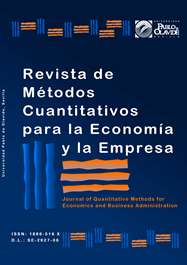Characterization of the productivity of a Mexican technology development company through fuzzy control
DOI:
https://doi.org/10.46661/revmetodoscuanteconempresa.5374Keywords:
productivity, technology-based company, fuzzy logic, Monte Carlo simulationAbstract
The development of a model that allows measuring the productivity of a technology-based company is presented, which is based on the interactions identified between the investment of the research department, computer fraud, and theft. These interactions are presented through a model of fuzzy variables in which the membership functions are developed for each of these. Likewise, the interaction rules are developed based on the conjunction of the fuzzy sets proposed for the Mamdani model. With these designs, it is possible to determine the degree of productivity, characterized by a fuzzy set. To test the model, Monte Carlo simulation was used with four scenarios. The simulations’ series results show that the fuzzy sets described allow to measure company’s productivity being analysed through the proposed fuzzy sets productivity ranges.
Downloads
References
Cabrera-Llanos, A.I., Ortiz-Arango, F., & Cruz-Aranda, F. (2019). Un Modelo de Minimización de Costos de Mantenimiento de Equipo Médico Mediante Lógica Difusa. Revista Mexicana de Economía y Finanzas, 14(3), 379-396. https://doi.org/10.21919/remef.v14i3.410.
CEPAL (2020). Acerca de Microempresas y Pymes. https://www.cepal.org/es/temas/pymes/acerca-microempresas-pymes.
Chattopadhyay, A.K., & Chattopadhyay, T. (2014). Monte Carlo Simulation. New York: Springer. http://link.springer.com/10.1007/978-1-4939-1507-1_10 (October 25, 2018).
Cheung, W.L., Pitcher, T.J., & Pauly, D. (2005). A Fuzzy Logic Expert System to Estimate Intrinsic Extinction Vulnerabilities of Marine Fishes to Fishing. Biological Conservation, 124(1), 97-111. https://doi.org/10.1016/j.biocon.2005.01.017
Dávila, G., Ortiz, F., & Cruz, F. (2016). Cálculo Del Valor En Riesgo Operacional Mediante Redes Bayesianas Para Una Empresa Financiera. Contaduria y Administracion, 61(1), 176-201. http://dx.doi.org/10.1016/j.cya.2015.09.009.
González, C. (2011). Lógica Difusa. Una introducción práctica. Técnicas de Softcomputing. Ed. Universidad de Castilla-La Mancha. https://www.esi.uclm.es/www/cglez/downloads/docencia/2011_Softcomputing/LogicaDifusa.pdf
Jamshidi, A., Yazdani-Chamzini, A., HajiYakhchali, S., & Khaleghi, S. (2013). Developing a New Fuzzy Inference System for Pipeline Risk Assessment. Journal of Loss Prevention in the Process Industries, 26(1), 197-208. https://doi.org/10.1016/j.jlp.2012.10.010
Kroese, D. (2011). Monte Carlo Methods. Lecture Notes. Department of Mathematics, School of Mathematics and Physics. The University of Queensland. https://github.com/dpkroese/Monte-Carlo-lecture-notes/blob/master/mccourse.pdf.
Passino, K.M. (1998). Fuzzy Control, Department of Electrical Engineering. USA: The Ohio State University. https://www2.ece.ohio-state.edu/~passino/FCbook.pdf
Sánchez, E.S. et al. (2015). Fuzzy-State Machine for Triage Priority Classifier in Emergency Room. In Springer, Cham, 1488–91. http://link.springer.com/10.1007/978-3-319-19387-8_361 (October 23, 2018).
Sivanandam, S.N., Sumathi, S., & Deepa, S.N. (2007). Introduction to Fuzzy Logic Using MATLAB. https://doi.org/10.1007/978-3-540-35781-0
Tah, J.H.M., & Carr, V. (2000). A Proposal for Construction Project Risk Assessment Using Fuzzy Logic. Construction Management and Economics, 18(4), 491-500. https://doi.org/10.1080/01446190050024905
Tejada, G. (2000). Tutorial de Lógica Fuzzy. Electrónica - UNMSM, 5, 18-29. https://revistasinvestigacion.unmsm.edu.pe/index.php/electron/article/view/4426
Vicent, I. (2014). Conjuntos difusos: aplicación al control de procesos. Prácticas Externas y Proyecto Final de Grado en Matemática Computacional. Universidad de Valencia.
Downloads
Published
How to Cite
Issue
Section
License

This work is licensed under a Creative Commons Attribution-ShareAlike 4.0 International License.
Submission of manuscripts implies that the work described has not been published before (except in the form of an abstract or as part of thesis), that it is not under consideration for publication elsewhere and that, in case of acceptance, the authors agree to automatic transfer of the copyright to the Journal for its publication and dissemination. Authors retain the authors' right to use and share the article according to a personal or instutional use or scholarly sharing purposes; in addition, they retain patent, trademark and other intellectual property rights (including research data).
All the articles are published in the Journal under the Creative Commons license CC-BY-SA (Attribution-ShareAlike). It is allowed a commercial use of the work (always including the author attribution) and other derivative works, which must be released under the same license as the original work.
Up to Volume 21, this Journal has been licensing the articles under the Creative Commons license CC-BY-SA 3.0 ES. Starting from Volume 22, the Creative Commons license CC-BY-SA 4.0 is used.










